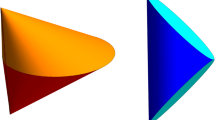Abstract
We present a new generalization of the classical trisecant lemma. Our approach is quite different from previous generalizations [8, 10, 1, 2, 4, 7]. Let X be an equidimensional projective variety of dimension d. For a given k ≤ d + 1, we are interested in the study of the variety of k-secants. The classical trisecant lemma just considers the case where k = 3 while in [10] the case k = d + 2 is considered. Secants of order from 4 to d + 1 provide service for our main result. In this paper, we prove that if the variety of k-secants (k ≤ d +1) satisfies the following three conditions: (i) through every point in X, there passes at least one k-secant, (ii) the variety of k-secants satisfies a strong connectivity property that we define in the sequel, (iii) every k-secant is also a (k +1)-secant; then the variety X can be embedded into ℙd+1. The new assumption, introduced here, that we call strong connectivity, is essential because a naive generalization that does not incorporate this assumption fails, as we show in an example. The paper concludes with some conjectures concerning the essence of the strong connectivity assumption.
Similar content being viewed by others
References
B. Adlandsvik, Joins and higher secant varieties, Mathematica Scandinavica 61 (1987), 213–222.
B. Adlandsvik, Varieties with extremal number of degenerate higher secant varieties, Journal für die Reine und Angewandte Mathematik 392 (1988), 16–26.
M. Barnabei, A. Brini and G. C. Rota, On the exterior calculus of invariant theory, Journal of Algebra 96 (1985), 120–160.
H. Flenner, L. O’Caroll and W. Vogel, Joins and Intersections, Springer Monographs in Mathematics, Springer, Berlin, 1999.
J. Harris, Algebraic Geometry, A First Course, Springer, Berlin, 1992.
R. Hartshorne, Algebraic Geometry, Springer, Berlin, 1997.
J. Y. Kaminski, A. Kanel-Belov and M. Teicher, Trisecant lemma for non-equidimensional varieties, Fundamental’naya i prikladnaya matematika (Fundamental and Applied Mathematics) 12, no. 2 (2006). Journal of Mathematical Sciences 149, no. 2 (2008), 1087–1097.
O. A. Laudal, A generalized trisecant lemma, in Algebraic Geometry Proceedings, Lecture Notes in Mathematics 687, Springer, Berlin, 1977.
Q. Liu, Algebraic Geometry and Arithmetic Curves, Oxford University Press, Oxford, 2002.
Z. Ran, The (dimension+2)-secant lemma, Inventiones Mathematicae 106 (1991), 65–71.
I. R. Shafarevich, Basic Algebraic Geometry, Springer, Berlin, 1977.
V. V. Shokurov, Algebraic curves and their Jacobians (Russian), in Current Problems in Mathematics. Fundamental Directions Vol. 36, Itogi Nauki i Tekhniki, Akad. Nauk SSSR, Vsesoyuz. Inst. Nauchn. i Tekhn. Inform., Moscow, 1989, pp. 233–273, 280.
F. Zak, Tangents and Secants to Algebraic Varieties, AMS Translations of Mathematical Monographs, American Mathematical Society, Providence, RI, 1993.
Author information
Authors and Affiliations
Corresponding author
Rights and permissions
About this article
Cite this article
Kaminski, J.Y., Kanel-Belov, A. & Teicher, M. Multi-secant lemma. Isr. J. Math. 177, 253–266 (2010). https://doi.org/10.1007/s11856-010-0045-6
Received:
Published:
Issue Date:
DOI: https://doi.org/10.1007/s11856-010-0045-6




